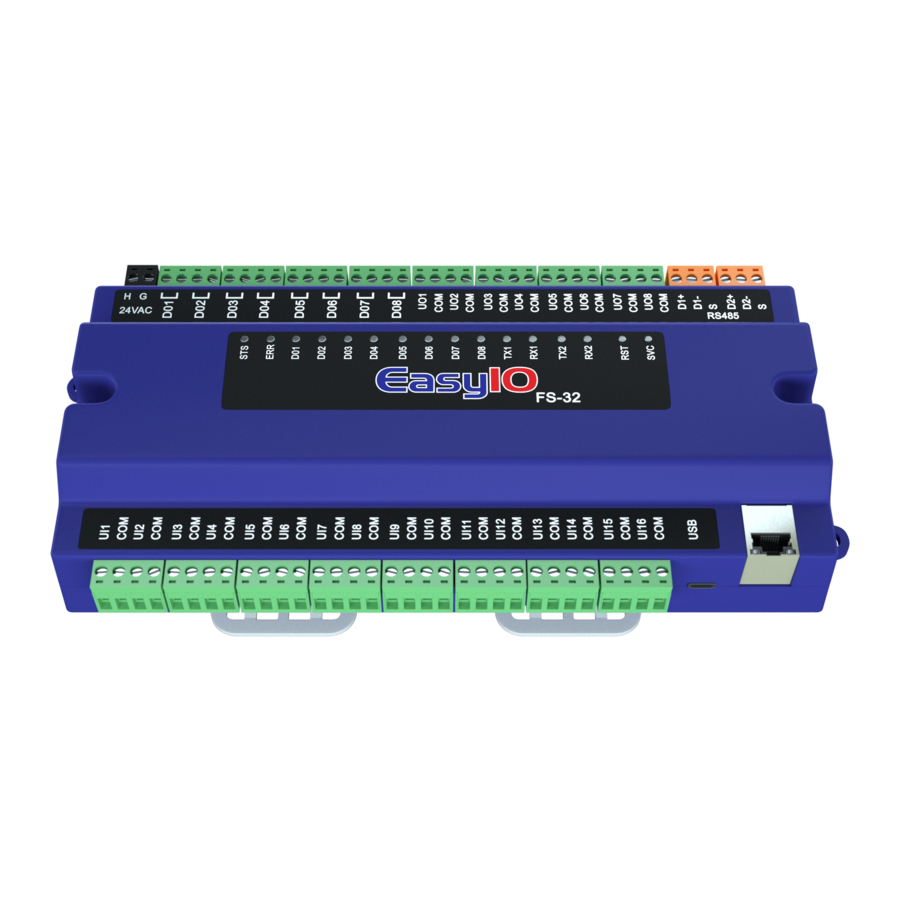
EasyIO FS Series User Manual
Modbus master
Hide thumbs
Also See for FS Series:
- User reference (18 pages) ,
- User manual (14 pages) ,
- User manual (16 pages)
Advertisement
Advertisement

Summary of Contents for EasyIO FS Series
- Page 1 FS Series Modbus Master v1.0 EasyIO FS Series Modbus Master User Guide...
- Page 2 FS Series Modbus Master v1.0 Document Change Log Dec 2019 Document created for FS series ONLY.
- Page 3 While every effort has been made to assure the accuracy of this document, EasyIO Holdings Pte Ltd is not responsible for damages of any kind, including without limitation consequential damages, arising from the application of the information contained herein.
- Page 4 FS Series Modbus Master v1.0 Federal Communication Commission Interference Statement This equipment has been tested and found to comply with the limits for a Class B digital device, pursuant to Part 15 of the FCC Rules. These limits are designed to provide reasonable protection against harmful interference in a residential installation.
-
Page 5: Table Of Contents
FS Series Modbus Master v1.0 Table of Contents Introduction ................................... 6 Prerequisites .................................. 6 Device Software Configuration Limitations ........................6 Configuring the Modbus Serial Network ........................7 Configuring the Modbus TCP Network ........................12 Configuring the Modbus TCP Gateway Network ......................16... -
Page 6: Introduction
FS Series Modbus Master v1.0 Introduction EasyIO FS Series supports Modbus as a Master Driver. It is capable of handling the following Modbus protocols; This document is compatible for both FS Series since the hardware profile of 2 models are identical. -
Page 7: Configuring The Modbus Serial Network
FS Series Modbus Master v1.0 Configuring the Modbus Serial Network The architecture of the driver is a tiered, parent/child structure as indicated below. The network object can be placed anywhere in the Sedona apps. It is recommended to create a separate folder for each network to allow logical identification of each “parent”... - Page 8 From the easyioFGModbus kit selections “drag & drop” the ModbusSerialNetwork object into your App. The object can be placed anywhere, directly in the tree, in the EasyIO folder, or in a new folder if desired. In this case, the object will be dropped into a new folder named “Modbus”.
- Page 9 FS Series Modbus Master v1.0 Step 4 Double click the ModbusSerialNetwork object to access the object property sheet. You will need to configure the serial network communications parameters according to the requirements Modbus device. Enable the network. **Tech Tip: - Please note that only Port 2(D2+ & D2- Terminals) on the FG Series controller can be used**...
- Page 10 FS Series Modbus Master v1.0 Step 6 Drop the required MODBUS register type object under the Device Object. The Register object must be a “child” of the “parent” Device Object. The use of folders within the Device Object is possible. It is recommended to use folders within the device object for better data management.
- Page 11 FS Series Modbus Master v1.0 Step 8 By default all “writable” registers have a “Read Write” property to enable the “write” function. If the register is a “ReadWrite” register and writing is required, enable the write ability by setting the “Read Write” property to...
-
Page 12: Configuring The Modbus Tcp Network
FS Series Modbus Master v1.0 Configuring the Modbus TCP Network The architecture of the driver is a tiered, parent/child structure as indicated below. The network object can be placed anywhere in the Sedona apps. It is recommended to create a separate folder for each network to allow logical identification of each “parent”... - Page 13 From the easyioFGModbus kit selections “drag & drop” the ModbusTCPNetwork object into your App. The object can be placed anywhere, directly in the tree, in the EasyIO folder, or in a new folder if desired. In this case, the object will be dropped into a new folder named “Modbus”.
- Page 14 FS Series Modbus Master v1.0 Step 5 Drop the required MODBUS register type object under the Device Object. The Register object must be a “child” of the “parent” Device Object. The use of folders within the Device Object is possible. It is recommended to use folders within the device object for better data management.
- Page 15 FS Series Modbus Master v1.0 Step 6 Set the register address for the desired point under the “address” property of the desired object type. Enable the point by setting the register “enable” property “true”. **Tech Tip: -The only MODBUS register addressing format supported by the EasyIOFGModbus kit is “Decimal”...
-
Page 16: Configuring The Modbus Tcp Gateway Network
From the easyioFGModbus kit selections “drag & drop” the ModbusTCPGateway object into your App. The object can be placed anywhere, directly in the tree, in the EasyIO folder, or in a new folder if desired. In this case, the object will be dropped into a new folder named “Modbus”. - Page 17 FS Series Modbus Master v1.0 It is possible to rename the ModbusTCPGateway object. In this case the ModbusTCPGateway object has been renamed as TCPGate. Step 3 Double click the ModbusTCPNetwork object to access the object property sheet. Enable the network by setting the Enable property to “true”.
- Page 18 FS Series Modbus Master v1.0 Step 4 Select and drag a ModbusTCPGatewayDevice object from the EasyIOFGModbus kit Sedona palette and drop it under the Network object. The TCP Gateway device must be a “child” of the “parent” TCPGate Network object.
-
Page 19: Technical Support
FS Series Modbus Master v1.0 Step 6 Set the register address for the desired point under the “address” property of the desired object type. Enable the point by setting the register “enable” property “true”. **Tech Tip: -The only MODBUS register addressing format supported by the EasyIOFGModbus kit is “Decimal”...








Need help?
Do you have a question about the FS Series and is the answer not in the manual?
Questions and answers